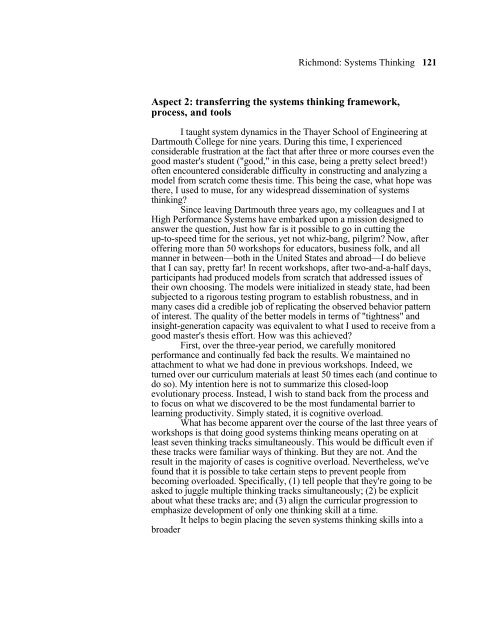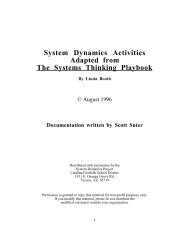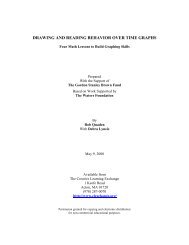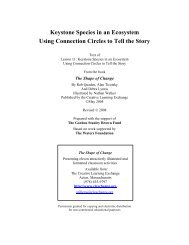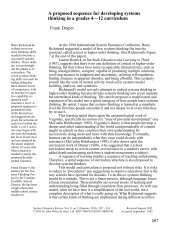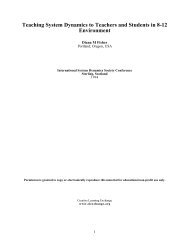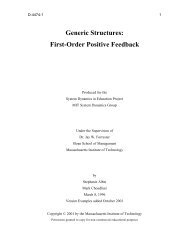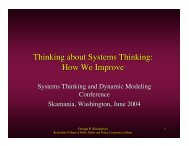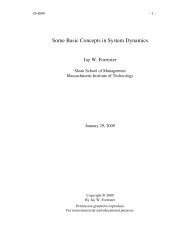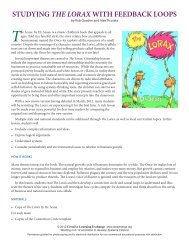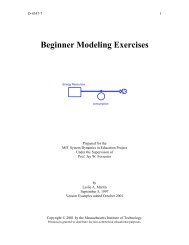Systems thinking: critical thinking skills for the 1990s and beyond
Systems thinking: critical thinking skills for the 1990s and beyond
Systems thinking: critical thinking skills for the 1990s and beyond
- No tags were found...
Create successful ePaper yourself
Turn your PDF publications into a flip-book with our unique Google optimized e-Paper software.
Richmond: <strong>Systems</strong> Thinking 121Aspect 2: transferring <strong>the</strong> systems <strong>thinking</strong> framework,process, <strong>and</strong> toolsI taught system dynamics in <strong>the</strong> Thayer School of Engineering atDartmouth College <strong>for</strong> nine years. During this time, I experiencedconsiderable frustration at <strong>the</strong> fact that after three or more courses even <strong>the</strong>good master's student ("good," in this case, being a pretty select breed!)often encountered considerable difficulty in constructing <strong>and</strong> analyzing amodel from scratch come <strong>the</strong>sis time. This being <strong>the</strong> case, what hope was<strong>the</strong>re, I used to muse, <strong>for</strong> any widespread dissemination of systems<strong>thinking</strong>?Since leaving Dartmouth three years ago, my colleagues <strong>and</strong> I atHigh Per<strong>for</strong>mance <strong>Systems</strong> have embarked upon a mission designed toanswer <strong>the</strong> question, Just how far is it possible to go in cutting <strong>the</strong>up-to-speed time <strong>for</strong> <strong>the</strong> serious, yet not whiz-bang, pilgrim? Now, afteroffering more than 50 workshops <strong>for</strong> educators, business folk, <strong>and</strong> allmanner in between—both in <strong>the</strong> United States <strong>and</strong> abroad—I do believethat I can say, pretty far! In recent workshops, after two-<strong>and</strong>-a-half days,participants had produced models from scratch that addressed issues of<strong>the</strong>ir own choosing. The models were initialized in steady state, had beensubjected to a rigorous testing program to establish robustness, <strong>and</strong> inmany cases did a credible job of replicating <strong>the</strong> observed behavior patternof interest. The quality of <strong>the</strong> better models in terms of "tightness" <strong>and</strong>insight-generation capacity was equivalent to what I used to receive from agood master's <strong>the</strong>sis ef<strong>for</strong>t. How was this achieved?First, over <strong>the</strong> three-year period, we carefully monitoredper<strong>for</strong>mance <strong>and</strong> continually fed back <strong>the</strong> results. We maintained noattachment to what we had done in previous workshops. Indeed, weturned over our curriculum materials at least 50 times each (<strong>and</strong> continue todo so). My intention here is not to summarize this closed-loopevolutionary process. Instead, I wish to st<strong>and</strong> back from <strong>the</strong> process <strong>and</strong>to focus on what we discovered to be <strong>the</strong> most fundamental barrier tolearning productivity. Simply stated, it is cognitive overload.What has become apparent over <strong>the</strong> course of <strong>the</strong> last three years ofworkshops is that doing good systems <strong>thinking</strong> means operating on atleast seven <strong>thinking</strong> tracks simultaneously. This would be difficult even if<strong>the</strong>se tracks were familiar ways of <strong>thinking</strong>. But <strong>the</strong>y are not. And <strong>the</strong>result in <strong>the</strong> majority of cases is cognitive overload. Never<strong>the</strong>less, we'vefound that it is possible to take certain steps to prevent people frombecoming overloaded. Specifically, (1) tell people that <strong>the</strong>y're going to beasked to juggle multiple <strong>thinking</strong> tracks simultaneously; (2) be explicitabout what <strong>the</strong>se tracks are; <strong>and</strong> (3) align <strong>the</strong> curricular progression toemphasize development of only one <strong>thinking</strong> skill at a time.It helps to begin placing <strong>the</strong> seven systems <strong>thinking</strong> <strong>skills</strong> into abroader


